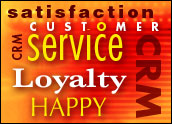
Online ad spending is poised to grow by as much as 30 percent in 2005, according to recent surveys conducted by Deutsche Bank in conjunction with MediaPost. Online advertising is beginning once again to garner large venture capital dollars. The growing Internet ad market promises to be a US$10 billion industry.
Now that the ad market is more mature and stable, certain commercial retailers find themselves in a good position to take advantage of it.
In particular, e-retailers (traditional brick-and-mortar businesses with an additional online channel to market) and pure-play commerce sites (“click-and-mortar” sites created purely for an Internet presence) are at the forefront of driving online ad expenditures in the upcoming year.
In order to do so, the first step they must take is to connect more closely to their online customers, namely through targeted advertising programs and other related campaigns. How?
Face the Facts
According to a recent report published by the U.S. Commerce Department, e-commerce expenditures are increasingly on the rise. Retail sales over the Internet rose each quarter of 2004 as compared to the previous year. The Online Publishers Association released data showing that consumers spent more time on e-commerce-related sites than at content-related sites during the last quarter of 2004.
In November alone, online shopping sites accounted for 17 percent of time spent online, according to data from Nielsen/NetRatings. The recently published Evolution of the Multi-Channel Consumer (EMC2) study conducted by Fry Inc., the e-tailing group Inc., and comScore Networks shows that many consumers use online resources to begin their decision-making process before purchasing an item or service. This is all great news for online advertisers, vendors and retailers alike.
Why the change in heart? There are many reasons why consumers are spending more and money on e-commerce sites. As consumers spend more time online, they are becoming more comfortable with the Internet. Many retailers are providing additional forms of advanced digital media that provide for more personal interactions. More retailers are integrating online and off-line promotional efforts. And as consumers’ lives become more complicated, it is simply easier to make purchases online.
The Fear Factor
While a handful of pure-play retailers have gained a high level of sophistication in the market rather quickly, more often retailers that have recently entered the online channel are less sophisticated. Many new online retailers must face the fear of “cannibalizing” their own brick-and-mortar shop and establish which content will sell best online.
E-retailers must factor in usability issues, such as how easy it is for its customers to find and purchase what they are looking for as well as how to fulfill orders quickly and effectively. Once e-retailers have faced the fear factor, they find that they have attracted more customers who are looking for a sophisticated and integrated shopping experience.
Tapping Opportunity
How can e-retailers tap into the increased opportunities? The EMC2 study shows that as consumers find they have less time to spend shopping, they require a convenient multichannel shopping experience. This trend goes to show the importance of delivering a consistent message and experience across all channels, including online ad campaigns.
The e-retailers who embraced this concept were the heaviest hitters in overall growth during the latest holiday season. E-retailers and pure-play sites can further maximize their online presence by providing a relevant site for each customer. Sites should develop highly targeted online advertising campaigns and related marketing promotions to deliver the most relevant and timely information to their best customers.
Ad campaigns can include a focus on internal ads such as cross-sell and upsell opportunities (promotions and special offers), external ads where payback is through either CPMs or revenue-share based on actions, and co-op ads (similar to sponsorships.) Behavioral targeting strategies can also offer a unique opportunity for e-retailers to further engage their most valuable customers, adding significant value for advertisers.
Upsell Options
E-retailers are beginning to understand that in order to drive future advertising and build revenue, they must leverage the most valuable segments of their audience and turn unsold, un-targetable ad inventory into revenue-generating inventory. E-retailers must exploit increased opportunities across new media to develop their sites and create a more intelligent proposition to allow customers greater purchasing power.
Targeting the consumer of an abandoned airline reservation on their next visit or via a weekly e-mail with a package deal to the previously researched destination is a great upsell opportunity. Targeting consumers within their current visit based on any of the previous pages they have seen or actions they have taken is another great opportunity. These are simple applications, but advertisers and e-retailers can understand, test, and measure them.
Advertisers Stand To Gain
What does this mean for online advertisers? The potential for online ad serving on e-commerce sites, specifically, is poised for tremendous growth. Given the advances in online targeting technology, advertisers are presented with a good opportunity to leverage the most responsive and intimate sales and marketing medium. The more relevant an offer is to a potential customer, the more likely they are to purchase from that advertiser.
Advertisers can target the right promotion, for the right product, at the right price, at the right time, to the right customer. More traditional advertising dollars will enter the online ad market as the potential for much greater revenue increases.
Eye on Vendors
What does this mean for vendors? In order to continue to meet changing client needs, online ad management solutions will need to become more sophisticated over the next year, focusing on providing accurate forecasting and ad inventory controls as well as increased ROI functionality. Behavioral targeting solutions will need to be easier to implement and maintain as well as become flexible enough to accommodate differing business models.
What does this mean for consumers? Consumers are more likely to experience longer-term loyalty to brands that have embraced this online advertising trend. Consumers will see online ads and various other campaigns that are more relevant based on their past behaviors and other online patterns. Consumers will benefit from e-retailers engaging, maintaining, and treating them with personalized care and attention.
Brian Handly is CEO and cofounder of Accipiter Solutions, Inc.


































